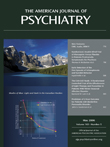To The Editor:
Recently, several candidate susceptibility genes of small effects for schizophrenia have been replicated in association studies. However, their possible roles in the manifestation of the disease remain obscure
(1) . Therefore, we read with great interest the article by Ayman H. Fanous, M.D., and colleagues
(2), which described the relationship between a high-risk haplotype in the
DTNBP1 gene and clinical features of schizophrenia. The conclusion—that the etiologically relevant variation in
DTNBP1 in presumptive linkage disequilibrium with the high-risk haplotype might be associated with high levels of negative symptoms—was derived from the observation that the high-risk haplotype frequency was higher in the subjects in the upper 40th percentile for the negative symptom factor.
However, the data in their Table 2 might suggest the opposite possibility. First, the frequency of the high-risk haplotype was higher in the upper 20%–40% subgroup for the negative symptom factor than in the upper 0%–20% subgroup (0.098 and 0.075, respectively). In addition, the high-risk haplotype frequencies in the upper 40% subgroup for four factors (negative, hallucinations, delusions, and manic) were higher in the broad-definition group than in the narrow-definition group. These results suggest that the high-risk haplotype in DTNBP1 was overtransmitted to the milder cases with schizophrenia, which is just the opposite of their interpretation.
This might be the same with
NRG1, another best-replicated positional candidate gene for schizophrenia. The high-risk haplotypes were associated with nondeficit schizophrenia but not with deficit schizophrenia
(3) .
A significant p value in an association study tells us nothing about the nature of the causal relationship between the gene and the disease
(1) . Therefore, it should be noted that a significant positive association with a disease does not necessarily imply susceptibility but rather may indicate resistance to the disease.
According to Kendler
(4), one of the most perplexing problems concerned with the schizophrenia-
DTNBP1 connection is that although reduced levels of
DTNBP1 were seen in the hippocampus of nearly all affected cases, only a subset of individuals with schizophrenia carries the high-risk
DTNBP1 haplotypes that reduce
DTNBP1 expression in the brain
(5) . However, if the high-risk haplotypes in
DTNBP1 were resistance genes and a reduced
DTNBP1 level in the brain was a resistance response to the pathogenesis of the disease, the brains of most patients would show such a change and a subset of patients who carry apparent high-risk
DTNBP1 haplotypes should have a genetically determined resistance that makes the disease milder.

